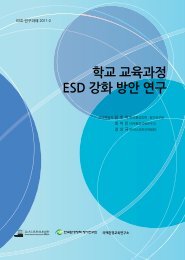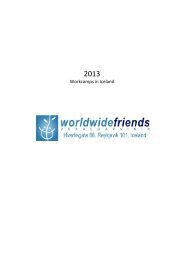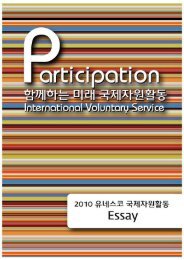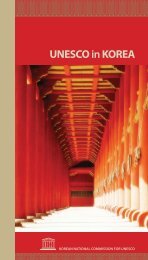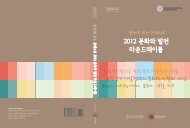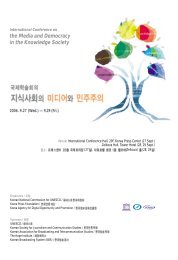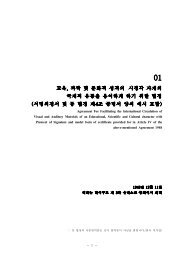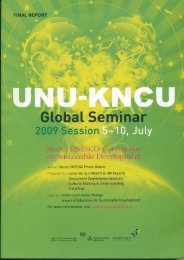DMZ ì¼ì ìí ííì ê´ë¦¬ë¥¼ ìí êµì 컨í¼ë°ì¤ - ì ë¤ì¤ì½íêµììí
DMZ ì¼ì ìí ííì ê´ë¦¬ë¥¼ ìí êµì 컨í¼ë°ì¤ - ì ë¤ì¤ì½íêµììí
DMZ ì¼ì ìí ííì ê´ë¦¬ë¥¼ ìí êµì 컨í¼ë°ì¤ - ì ë¤ì¤ì½íêµììí
Create successful ePaper yourself
Turn your PDF publications into a flip-book with our unique Google optimized e-Paper software.
Hanbando Eco-Peace Park<br />
Strengthening the ecosystem integrity of Korean peninsular<br />
and Encouraging the conservation and sustainable use of <strong>DMZ</strong> areas…<br />
Dr. Hag Young Heo<br />
IUCN Asia Regional Protected Area Programme / Korea National Park Service<br />
1. Background<br />
In 1945, the Korean peninsula was liberated from the Japanese colonial rule. In that<br />
process, the military demarcation line on the 38th parallel divided the peninsula into two<br />
Koreas. After Korean war, Korean peninsula has been separated over the past 50 years by<br />
<strong>DMZ</strong>(De-Militarized Zone), which is the area covering 2km to the south and north from<br />
the Military Demarcation Line(MDL), and the total area is about 907km2. And as a<br />
southern neighborhood area, there is a Civilian Control Zone (CCZ) which is the area<br />
within 10km to the south from the MDZ. These areas have been long known for its rich<br />
biological diversity and tourism potential, as it is home to hundreds of species of plants<br />
and animals, including some endangered.<br />
The need to conserve these areas has been highlighted along with rising national interest<br />
in protected areas, which has increased greatly due to a new awareness of the importance<br />
of conserving ecosystems and biodiversity. In addition, the ROK government has stepped up<br />
efforts to connect and conserve the <strong>DMZ</strong>, with initiatives to create an ecological park and<br />
other types of protected areas. However, at the same time, there are various kinds of plans<br />
to develop these areas and some development activities were conducted and caused<br />
ecological degradation.<br />
In order to strengthen the ecosystem integrity of Korean peninsular and to effective<br />
conserve Korean peninsular’s biodiversity as a whole, we should promote connecting the<br />
main ecological axewhich was divided by <strong>DMZ</strong>. To accomplish them, we need more<br />
efforts to raise the understanding about biodiversity and protected area systems of both<br />
Koreas and we also need to take appropriate actions to conserve neighboring areas of<br />
<strong>DMZ</strong>. On this process, the suitable international co-operations including DPRK could be<br />
contributed a lot for continuous and effective conservation and management of <strong>DMZ</strong> areas.<br />
2. Biodiversity of the Korean peninsula<br />
The Korean Peninsulais dominated by diverse forest types, wetlands, coastal areas and so<br />
on. Korean peninsula has a geographical feature that highlands are located in the east and<br />
50 ❙ <strong>DMZ</strong> 일원의 생태⋅평화⋅지역발전



